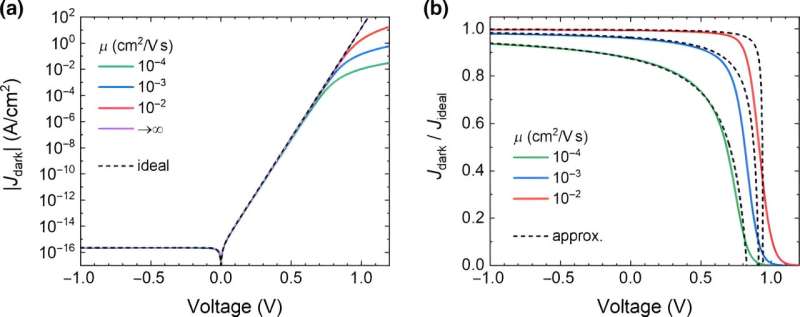This article has been reviewed according to Science X's editorial process and policies. Editors have highlighted the following attributes while ensuring the content's credibility:
fact-checked
peer-reviewed publication
trusted source
proofread
Moving beyond the 80-year-old solar cell equation

Physicists from Swansea University and Åbo Akademi University have made a significant breakthrough in solar cell technology by developing a new analytical model that improves the understanding and efficiency of thin-film photovoltaic (PV) devices.
For nearly eight decades, the so-called Shockley diode equation has explained how current flows through solar cells; the electrical current that powers up your home or charges the battery bank. However, the new study challenges this traditional understanding for a specific class of next-generation solar cells, namely: thin-film solar cells
These thin-film solar cells, made of flexible, low-cost materials have had limited efficiency due to factors that the existing analytical models couldn't fully explain.
The new study, published in PRX Energy, sheds light on how these solar cells achieve optimal efficiency. It reveals a critical balance between collecting the electricity generated by light and minimizing losses due to recombination, where electrical charges cancel each other out.
"Our findings provide key insights into the mechanisms driving and limiting charge collection, and ultimately the power-conversion efficiency, in low-mobility PV devices," said the lead author, Dr. Oskar Sandberg of Åbo Akademi University, Finland.
Previous analytical models for these solar cells had a blind spot: "injected carriers"—charges entering the device from the contacts. These carriers significantly impact recombination and limited efficiency.
"The traditional models just weren't capturing the whole picture, especially for these thin-film cells with low-mobility semiconductors," explained the principal investigator, Associate Professor Ardalan Armin of Swansea University.
"Our new study addresses this gap by introducing a new diode equation specifically tailored to account for these crucial injected carriers and their recombination with those photogenerated."
"The recombination between injected charges and photogenerated ones is not a huge problem in traditional solar cells such as silicon PV which is hundreds of times thicker than next generation thin film PV such as organic solar cells," Dr. Sandberg added.
Associate Professor Armin said, "One of the brightest theoretical physicists of all times, Wolfgang Pauli once said 'God made the bulk; the surface was the work of the devil.' As thin film solar cells have much bigger interfacial regions per bulk than traditional silicon; no wonder why they get affected more drastically by 'the work of the devil'—that is recombination of precious photogenerated charges with injected ones near the interface."
This new model offers a new framework for designing more efficient thin solar cells and photodetectors, optimizing existing devices, and analyzing material properties. It can also aid in training machines used for device optimization marking a significant step forward in the development of next-generation thin-film solar cells.
More information: Oskar J. Sandberg et al, Diode Equation for Sandwich-Type Thin-Film Photovoltaic Devices Limited by Bimolecular Recombination, PRX Energy (2024). DOI: 10.1103/PRXEnergy.3.023008
Journal information: PRX Energy
Provided by Swansea University




















